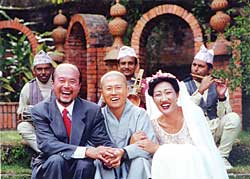 7 AM, Thamel. Kim Hong-Sung and his wife Jeong Myeong Kyeong are sipping fragrant herbal tea at Picnic, the little Korean kitchen they help run with a Nepali partner. It serves an assortment of mouthwatering Korean cuisine-bibimbap, kimchi, Korean-style sushi, and caters to a constant stream of Korean expatriates, tourists, and Nepalis throughout the day.
7 AM, Thamel. Kim Hong-Sung and his wife Jeong Myeong Kyeong are sipping fragrant herbal tea at Picnic, the little Korean kitchen they help run with a Nepali partner. It serves an assortment of mouthwatering Korean cuisine-bibimbap, kimchi, Korean-style sushi, and caters to a constant stream of Korean expatriates, tourists, and Nepalis throughout the day. The day's first customer has yet to arrive and the two savour a few quiet moments as they leaf through a stack of mountain magazines, mostly in Korean. Surrounded by framed pictures shot by Kim during travels in Ladakh, Sikkim and Darjeeling, the couple discusses the merits of running a Korean kitchen in Kathmandu. "I just enjoy cooking," says Jeong. "And it's a small place. You get to know the staff and the customers. There are so many interesting stories here."

And stories are just what the writer couple love. Thirty-four year-old Jeong, who publishes Himalaya News (a Korean journal about Nepali culture and travel), with her husband, is keen to someday write a novel based on her experiences in the kitchen. "I need to gather some more experience, first," says Jeong. After all, the couple aren't just restauranteurs-Jeong is a former copywriter for LG Advertisement Agency, and has already published an essay book The Japan Life Story about her experience of living in Japan, where she graduated from Tokyo Communication Art College. "Believe me, Korea and Japan are very different. At first glance, things appear similar. But there are small, small things that are different," she says emphatically. "Nepal and India are much more similar in comparison," says Kim, a writer, poet and photographer, who is currently working on a novel. "It's a love story about a Korean couple travelling in the Himalaya," says Kim. He doesn't look particularly happy, though. "I've rewritten it twice. It's partly fiction, partly fact."
The story could well be semi-autobiographical. Kim and Jeong, self-confessed mountain-lovers spent four months travelling in the Indian Himalaya, in Ladakh, Darjeeling, Sikkim, Dharamsala and Kathmandu in 1996. They fell in love with the mountains, and even more with each other. No surprise that they got married in Kathmandu in 2000.
 Today, one of their aims in life is informing and educating Koreans about Nepal, its people, its culture, its literature. As they spent more time in Nepal, made more Nepali friends and understood how things work here, Jeong and Kim realised that they could play a role in improving the lives of Nepalis in Korea. They help Koreans understand the situation of migrant Nepali workers in Korea through articles in Himalaya News and on their webpage. A 1999 article was on the experiences of two Nepali migrant workers affected by the economic recession in Korea. "The response among the Korean public was amazing. It was one of embarrassment and shame," says Kim. "There were many people who wanted to meet the two, and others even raised funds to help them."
Today, one of their aims in life is informing and educating Koreans about Nepal, its people, its culture, its literature. As they spent more time in Nepal, made more Nepali friends and understood how things work here, Jeong and Kim realised that they could play a role in improving the lives of Nepalis in Korea. They help Koreans understand the situation of migrant Nepali workers in Korea through articles in Himalaya News and on their webpage. A 1999 article was on the experiences of two Nepali migrant workers affected by the economic recession in Korea. "The response among the Korean public was amazing. It was one of embarrassment and shame," says Kim. "There were many people who wanted to meet the two, and others even raised funds to help them." Since he first visited Nepal in 1991, trekking with two Korean alpinists in the Langtang region, Kim says the travel bug has not left him. In 1992, he travelled to Ladakh; the next year he went from China to Pakistan along the Karakoram highway; and in 1994 he trekked around the Annapurna and revisited Langtang. In 1996 he decided to chuck his job as an overworked editor back home and set up base in Nepal, spending a year with Jeong at the Korean temple in Lumbini and then moving to Kathmandu.
"The Himalaya touched my soul," says Kim a former editor of The Man and Mountain, one of Korea's popular mountain magazines. Today Kim lures even more Koreans to Nepal and other Himalayan destinations through his writings in emountain, still another Korean mountain magazine.
Nepal for Kim isn't just mountains. He is fascinated by the pipal tree. "I'm a Buddhist, I believe the pipal tree is Buddha's mind. While other trees grow in a manner that represses the growth of other beings, the peepal tree grows in such a way that it doesn't choke others plants below, in fact the pipal sustains them."
Kim is the son of a North Korean refugee. His father lost his home during the Korean War. "At times, I still feel lost," he says. He has now found refuge in the mountains. The couple now spend their days writing, travelling when they can, but also cooking.
Kim and Jeong have another literary connection to Nepal: they helped their friend Finjo Lama translate Kanak Mani Dixit's The Adventures of a Nepali Frog, a tale about the travels of Bhakta Prasad Bhyaguto from the rice fields of Kathmandu to Jomsom. "Korean readers really enjoyed it," says Jeong.


